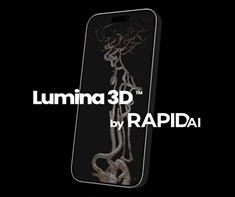 RapidAI has received US Food and Drug Administration (FDA) 510(k) clearance for Lumina 3D—an “industry-first”, automated 3D imaging reconstruction solution designed to replace manual workflows with an artificial intelligence (AI)-powered approach based on the latest “groundbreaking” AI technology advances.
RapidAI has received US Food and Drug Administration (FDA) 510(k) clearance for Lumina 3D—an “industry-first”, automated 3D imaging reconstruction solution designed to replace manual workflows with an artificial intelligence (AI)-powered approach based on the latest “groundbreaking” AI technology advances.
“Obtaining high-quality 3D images within minutes of a CTA [computed tomography angiography] scan marks a significant advancement and milestone in neuroradiology,” stated Vivek Yedavalli (Johns Hopkins School of Medicine, Baltimore, USA). “When radiologists require a detailed view of the vasculature for an accurate diagnosis, challenges related to quality, availability, time and cost present major obstacles. As head and neck CTA volumes increase, we continue to face a shortage of CT technicians and neuroradiologists. Lumina 3D addresses these issues by providing near-real-time, crystal-clear 3D views, vessel segmentation, and bone removal. This technology can assist in detecting anomalies, dissections and stenosis more swiftly and accurately, potentially improving patient outcomes, significantly enhancing neuroradiologists’ workflows, and supporting the radiology community.”
A RapidAI press release notes that manual CTA reconstructions take considerable time—even with available resources—and turnaround times may stretch to hours, which can delay critical diagnoses, and significantly hinder radiologists and neurointerventionists. But, according to the company, Lumina 3D accomplishes this “in minutes” and runs in real-time, and is designed for large-scale applications, ensuring 24/7 availability for hospitals of all sizes.
Engineered for speed, accuracy, and efficiency, Lumina 3D alleviates the workload for imaging technologists and radiologists, boosts productivity, and can accelerate diagnosis and treatment processes, ultimately enhancing patient care and hospital throughput, RapidAI further claims.
“Having immediate access to high-quality 3D images of vascular structures marks a significant advancement in neurointerventional surgery,” commented Daniel Gibson (Goodman Campbell Brain and Spine, Indianapolis, USA). “Previously, navigating challenging anatomy required a process of trial and error. Lumina 3D changes the paradigm by removing the guesswork with near-instantaneous visualisation of complex anatomy. With a 98% DICE score and results available in minutes, Lumina 3D’s level of automation, speed, and accuracy, is unprecedented. We are entering an era of precise procedural planning where initial device selection is optimised for individual patient anatomy. Joining the best-in-class RAPID suite of products, this is a technology that delivers not just better imaging but, potentially, better outcomes.”
As part of RapidAI’s Enterprise platform, Lumina 3D is said to “seamlessly” integrate into existing workflows, providing reconstructions to clinicians throughout the hospital network. The company states in its recent release that neurointerventional specialists can directly visualise compressed images of the aortic arch, carotid tortuosity, and entire neurovasculature, on mobile devices—enabling faster and more accurate access planning and catheter selection, thereby reducing procedure times and enhancing first-pass reperfusion rates.
Lumina 3D is exclusively deployed on Rapid Edge Cloud, which—according to RapidAI’s recent release—is “the only engine in the industry” that offers hospitals the flexibility of on-premises, cloud or hybrid infrastructure. This ensures “unmatched” speed, security, and scalability, which the company describes as a significant advantage for healthcare institutions optimising AI-driven imaging solutions.
“At RapidAI, our brand promise extends beyond just providing AI solutions—we are dedicated partners in navigating the evolving complexities of clinical decision-making and care coordination for radiologists and interventionalists,” said Karim Karti, chief executive officer (CEO) at RapidAI. “By delivering the most advanced deep clinical AI-driven insights for imaging support, improving workflow efficiency, and providing measurable ROI [return on investment] for hospital service line programmes, we empower clinicians to make faster, more confident decisions. Lumina 3D builds upon our deep clinical expertise in neuroscience, redefining AI-powered 3D imaging and paving the way for the next generation of advanced AI imaging and clinical decision-making technology.”












